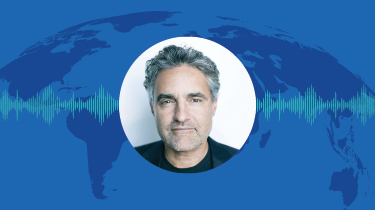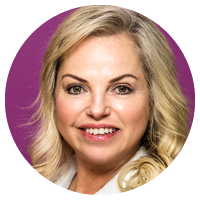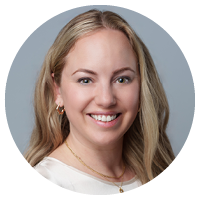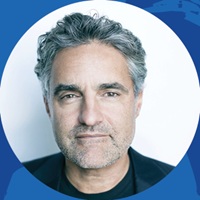Season 2 - EP 02
Growing a plant-based food business into new markets
April 2, 2025

Big Mountain Foods: Plant-based success, family-style
Join Bruce Croxon as he sits down with Kimberly Chamberland and Jasmine Byrne, the mother-daughter team behind Big Mountain Foods. Trailblazers in the plant-based protein market since the 1980s, they share firsthand experiences on:
- Expanding operations into more than 3,500 stores across North America
- Preserving a family-run culture while building their business
- Meeting the growing demand for sustainable, allergen-free products
- Partnering with EDC and BDC to grow without external investors
Where to listen
Never miss an episode that could transform your business. Follow us on your favourite streaming platforms for new episodes every month.
Bruce Croxon (00:03): Hi, and welcome back to the Export Impact Podcast, brought to you by Export Development Canada (EDC). I’m Bruce Croxon and I’m the host of the podcast this year that looks at the true impact Canadian exporters are having internationally.
Today, we’re speaking with two incredible entrepreneurs who have been shaping the plant-based industry for decades. We’re joined by Kimberly Chamberlain and Jasmine Byrne, the mother-daughter duo behind Big Mountain Foods, a family-run business that has been a pioneer in the plant-based protein market since the 1980s. Today, their products can be found in more than 3,500 stores across North America and they continue to scale their operations with purpose.
I’d like to begin today’s episode by acknowledging that we’re recording from my office in Toronto, which is on the traditional unceded territory of many nations, including the Missassaugas of the Credit, the Anishnabeg, the Chippewa, the Haudenosaunee, and the Wendat Peoples, and is now home to many diverse First Nations, Inuit and Metis. We value taking this moment to deepen the appreciation of our Indigenous communities—wherever we are—and to remind ourselves of our shared debt to Canada’s First Peoples.
So, welcome to the show, first of all, and congrats on your success. But primarily thank you very much for being here with us today.
Kimberly Chamberlain (01:33): Thank you. Thank you for having us. What an intro.
Bruce Croxon (01:38): You know, I’m a writer as well. I was on the website though last night, just sort of getting ready. I’m not a customer, full disclosure, but I can see myself being one because after being on the website, I actually felt healthier just by hanging out there. But what I’m curious about is, Kimberly, this was in the ’80s that you guys got going before, in my memory anyway, where this sort of health food alternative craze became mainstream. What gave you the inspiration way back then, and how did you get going?
Kimberly Chamberlain (02:09): Well, I’m born into the industry, so my mother was in the industry. My grandmother was in the industry, but to a different spectrum. She was more fine steakhouses, etcetera. And my mother had a passion for natural foods from the day she was born. So, all of my siblings were raised with organic food, vegetarian diet, and I followed in her footsteps.
Bruce Croxon (02:36): Isn’t that fascinating? What part of the province are you residing?
Kimberly Chamberlain (02:41): Actually, I’m from United States, so she was from southern California and then she moved to Vancouver, BC in the early ’80s and I never left.
Bruce Croxon (02:51): Well, that helps explain it. California is usually always a decade or two ahead, in terms of healthy trends. And Jasmine, what was it like growing up and becoming the next generation of this trend and how did you find your role in the company?
Jasmine Byrne (03:07): For me, working as a young kid, I think I started working as early as I possibly could on the weekends, evenings and then I dragged my friends into it to try to make some extra money. But what really got me going and why I wanted to join Kim was just seeing how hard she was working and I knew this couldn’t be a forever thing. We had to make it easier, expand, bring on some employees. Watching Kimberly as I was growing up, making every single batch by scratch of burgers and going and delivering to all the local restaurants, cafes, retailers, I just felt she needed some help and we had to grow this because you can’t be doing that hard work forever.
Bruce Croxon (03:58): Good point. There’s amazing data and statistics out there about how well family-run businesses actually do. Because you’re born into it, there’s sort of this built-in passion and you know, everybody all hands on deck kind of thing. But I imagine it must lead to some pretty interesting dynamics around the table, growing up as you try and leave the business behind for an hour or so. What was the dynamic like?
Jasmine Byrne (04:23): Oh, it’s still a challenge. We’ve actually managed to drag my brother now into the business and he’s older than me and he now is with us a little late in the game. But the spouses and in-laws and everything, they try to remind us to keep business at work, but everyone also likes to chat and gossip about it, too. It ends up being the highlight of the dinner table, just chatting about work and what we have going on, challenges, successes. But what we don’t do well is we don’t celebrate the successes enough. We’re moving so fast that we try to, you know, when we’re travelling, take one extra day for ourselves to go for a nice dinner, or do some sightseeing, but it's tough.
Bruce Croxon (05:08): Very important. So, I should remind the viewers that Big Mountain Foods has grown significantly in recent years. You’ve expanded your presence, as I said, off the top to more than 3,500 stores across North America. You’re running this business, it sounds like its origins were in California, but the footprints in Canada. What got you believing, or what led to the stepping off outside the borders here, and looking at international markets? Was it a walk in the park, or was it very different in terms of entering the United States, or was it because you had roots there that it made it a little easier?
Kimberly Chamberlain (05:43): I think it’s the roots there that made it easier. Social media customers asking for the product, winning the lottery at the Natural Food Expo when we had a little table at the Canadian Pavilion and Kroger came along and listed us nationally, while we were in a 3,200-square-foot facility. It’s been a very exciting journey the past decade, but super challenging.
Bruce Croxon (06:10): So, let me just double-click on that: You’ve got a small table, you’re at a booth, you’re at a show, Kroger comes by, obviously, you’re putting your best foot forward with everybody, But when the order came in, tell me about that day or week or month when you had to figure out how, I’m assuming a relatively small Canadian company had to service one of the giants. Like what were some of the challenges that you were immediately facing, you thought you were going to face, that you overcame or some of the challenges that you had dealing with those big customers that still exist today?
Kimberly Chamberlain (06:46): Well, we were so excited about the opportunity that we didn’t even see a challenge. The challenge happened when we went to Cincinnati. Jasmine was actually eight months pregnant with her little guy and we thought we were just going to get listed down the I-95. [KT1] [TK2] Next thing you know, she lists us straight across the country. That was fine, we’re not afraid of working and getting the job done. What was challenging was that it happened in January to launch in June and COVID-19 hit, so it was a blessing and a curse in disguise.
The blessing was we got the account. The future looked super promising. The challenge was our facility was so small and Vancouver commercial real estate was just insane. Couldn’t find the location. So, we found a building, 70,000 square feet. We went from 230-, 200-square-foot facilities to 70,000. It didn’t matter—we got Kroger. It’s the biggest retailer in the U.S. We got WinCo. Foods. We got Sprouts. Things were just awesome. And then COVID became a really, really real thing. We launched at Kroger during a time where we couldn’t travel to go and monitor, promote, or do demos. It was pretty scary in 2020-2021, but we pulled through.
Bruce Croxon (08:17): Congratulations. I mean, looking back on it, if you had to sort of isolate the Top 3 things you learned about exporting through this journey, or if you know two or three things that stick out for you, what would they be?
Kimberly Chamberlain (08:32): I suppose you could tiptoe, but we’ve been at it for so many years that this was an incredible opportunity. That’s a tough one because everything was out of our control.
Jasmine Byrne (08:45): I think besides COVID, one thing Kim and I have definitely battled with over the years and still, it’s a challenge finding the right people. Not just their resumes and not just what they’ve done in their career, especially on the sales and marketing side of things. It’s about do they fit the culture? Do they believe in the brand? Do they understand how to sell it? We ran into quite a few challenges because we’re sold in produce. We had sales personnel that really believed that you had to move tonnage and it had to be cheap and that’s the only way we’re going to sell. Especially when you’re going up against tofu, which naturally is a cheaper item. We’re trying to come in as a premium, convince the retailers that, you know what, we’re actually going to charge more. We’re still going to see the same amount of velocities and we’re actually going to see tofu become more of a premium option.
And we’re upscaling it and convincing our salespeople that were working for us, our tactic and that we work premium. That definitely has been one of our biggest challenges: Getting people on board who will go forward with the pricing strategy we want and are looking for. Our pricing strategy has worked. We’re one of the top performing tofu brands in the U.S. and definitely the Top 5 in plant-based. So, it was just a lot of battles with pricing and how to go to market.
Bruce Croxon (10:21): It’s so interesting. You know, it's hard enough as it is and then when you’re breaking new ground in a category where you’re having to educate—not only the consumer, but the marketplace and the employees—that this leap of faith is worth it. I can see how that would rank right up there. I mean, you're fighting on all fronts, but as you said, it paid off and it sounded like it was like, let’s think long term here and not just take the short-term potential win. We’ve got a vision and let’s stick to it. Were there any programs or services coming out of Canada that helped Big Mountain scale its operations internationally? What were those and how were they helpful?
Kimberly Chamberlain (11:01): First thing is we received a $2-million grant just for being an essential worker. So, that’s actually what gave us the motivation to move into the new location. Jasmine, you could probably address some of the other programs.
Jasmine Byrne (11:18): Since we started to scale, Kim and I, we literally would talk to anyone who would talk to us. We travelled to every single show, went to every single webinar and in-person speaking session, trying to learn how we could raise money without taking on external investor. And we’re actually proud, we still only have our single owner to this day, even though we’ve scaled this big. We haven’t taken on any external investments. But what we did do is work with BDC and EDC and with their support, we were able to get backed by federal and provincial grant programs and kind of like a cost-sharing thing, which was excellent.
I advocate for grants and it can seem really daunting to entrepreneurs to sit down and write the applications. But I do believe that the Canadian government, both provincial and federal, are really on your side. And once you start speaking with them, emailing you grants that are coming up and we’ll look at the grants for you before you submit them. So, a lot of support from the Canadian government. We’re really proud to be producing here.
Bruce Croxon (12:31): That’s so encouraging to hear. As an investor myself, it’s not exactly always music to your ears when you hear about how entrepreneurs don’t have to raise outside equity money, which can be quite expensive if you properly tap into what EDC and BDC have to offer. So, that's the great piece of advice for entrepreneurs who are listening in, that are thinking about going outside of our borders. It doesn’t necessarily have to be done by giving up equity if you’re conversant with what programs the government has to offer.
Let me just switch gears for a second. I want to check in on the industry. I did a little bit more homework about the sort of category and space that you’re in—that you’re part of a $46-billion industry in 2024 that’s expected to get as large as $104 billion by 2039. I believe 8.5% growth a year compounded, which as an investor, those are numbers that you really do like to see. You’re obviously in the thick of it and I was actually curious because you launched this soy-free tofu. Soy is growing as well, still at a less aggressive pace than the overall industry. What was behind the introduction of the soy-free tofu? Is that in response to a health perception, or something that you guys are just once again trying to stay out in front of?
Kimberly Chamberlain (13:58): Everything Big Mountain does is allergen-free and that came about because Jasmine’s celiac; my other daughter, is lactose intolerant. We were actually doing a demo at Safeway and we had our cauli crumble we were doing these little pizzas and a mother came along with her little daughter and she just couldn't stop eating these samples we had. And then she looked at the ingredients and it had walnuts in it and then she says, “Oh my God, I’m so sorry, but my daughter can’t take this to school.” So, then we just decided that all the plant-based products out there are either full of soy, wheat, nuts and what could we do to stand out and still be nutritious? So, we pivoted to sunflower seeds, which are actually grown in Canada and more consistent. Sometimes, walnuts can be bitter, more expensive.
We pivoted to sunflower seeds and we’re always merchandised wherever tofu is. But just because you’re vegan, plant-based or want to cut down on your meat consumption, doesn’t mean you always want to eat crumbles and sausages and burgers. That was one of the challenges we had during the whole COVID thing is tofu actually started out being chickpea and then there was one of the largest chickpea droughts since the ’80s. So again, we had to pivot and we ended up finding a fava bean and fava bean is actually the most regenerative legume in the legume family. They use fava to restore the soil for canola, corn, etc. Because of the length of the roots, it rejuvenates the soil. So, it was simply out of giving the consumer an option.
Bruce Croxon (15:55): It sounds like there’s a ton of reacting to market conditions. But there’s a question that I’ve always wanted to ask when I think about this industry: Do you think the change in eating behaviour is more due to us wanting to be healthier, or how big of an environmental influence is at work right now where people are recognizing that meat was a major contributor in the growing of wheat and the cutting down of forest to get catalysts? How big a factor is that starting to be and how do you guys make sure that what you continue to do is sustainable and environmentally friendly? Two-part question there.
Kimberly Chamberlain (16:33): Sustainability is No. 1. When they survey folks as to why you’re going plant-based, it’s sustainability and cruelty and health. But I would say No. 1 is sustainability.
Bruce Croxon (16:47): That’s the market you’ve really captured, right? People who care about the future of the planet, these are things that I get, what I need taste good and as well, I feel good about my contribution or lack of contribution to footprint, if you will.
Kimberly Chamberlain (17:01): I will say that in my personal family with my mother, it was all about natural foods and health and organically being conscious of the environment just came naturally to her.
Bruce Croxon (17:15): That’s very encouraging for me to hear. Running the business as a family, back to that for a second. I mean, how do you guys maintain the family-oriented culture as you’ve scaled to be so big? I heard you say earlier in the podcast that you’ve brought another family member in recently. But talk to the audience a little bit about the whole dynamic of running a successful business from within a family and sort of the dynamics, or challenges, or positives even that that can create.
Kimberly Chamberlain (17:48): I think that the whole relationship works perfectly as long as you have respect for each other.
Jasmine Byrne (17:59): And really knowing your strengths and weaknesses and kind of staying in your lane. Respect is No. 1, for sure. And then just really making sure you both are aware of what you enjoy doing and take off from the other person’s plate what they don’t like enjoy doing, so we can live in more of a harmonious environment. I love operations—that's what I enjoy doing. And leading people, leading teams, figuring out problems and executing Kimberly's vision. Whereas Kimberly loves sales. Now, we do have to compromise and I am on the road with her a lot being outer-facing and working the trade shows. But she’ll recognize that, you know, maybe I don’t want to be out talking to people the whole time, so I’ll be cooking in the background and then when someone important comes along, we chat with the person together. So, just definitely knowing each other’s strengths and weaknesses I think has gotten us this far.
Bruce Croxon (18:52): I’m hearing open-mindedness, respect, understanding who you are, willingness to stay in your lane. OK, got it.
Kimberly Chamberlain (19:00): We genuinely love each other. Actually, her and her husband bought a house right next door to me.
Bruce Croxon (19:06): Oh my God.
Kimberly Chamberlain (19:07): We literally travel together, play together, work together. For a hobby, we’re boaters. They bought a boat. It’s in a marina.
Bruce Croxon (19:17): Amazing. It sounds like you got a heck of a head start if you're that tight. Congratulations on that. Listen, last question just in closing, what advice would you have? Because there’s going to be a lot of entrepreneurs and people from all over Canada listening to your story and listening to what you had to say. Again, congrats on all your success. But what advice would you give to other Canadian businesses looking to scale internationally?
Kimberly Chamberlain (19:45): Stay focused. Stay positive. Don’t allow the world to beat you down because it will. It’ll gobble you up.
Bruce Croxon (19:56): Well, it’s a heck of a journey being an entrepreneur and it’s not for everybody. It’s not one that everybody can relate to. But this has been great and I want to just say thanks for joining us today. It’s been really fantastic hearing about your success and the innovative strides you’re making and the fact that it’s also good for the planet is just sort of the cherry on top. I’ve really enjoyed hearing this story, so we really, really appreciate your time and insights.
Kimberly Chamberlain (20:26): Well, thank you for having us. It was great chatting with you and hopefully, you will be a consumer one day.
Bruce Croxon (20:33): Well listen, I told you I felt good on the website and the next time in the grocery store, I am going to check out the products. I really, really appreciate the education and getting introduced to this opportunity.
Kimberly Chamberlain (20:48): Awesome. Thank you very much.
Bruce Croxon (20:50): Thanks for joining us today on the Export Impact Podcast. If you enjoyed today’s episode, we’d love for you to subscribe, rate, and leave us a review on your favourite streaming platform. Until next time.
Host & guests
-

Guest
Kimberly Chamberland
CEO and founder, Big Mountain Foods Ltd.
-

Guest
Jasmine Byrne
COO, Big Mountain Foods Ltd.

Host
Bruce Croxon
Founder of Round13 Capital, regular commentator on BNN Bloomberg and former Dragon on CBC’s Dragons’ Den


